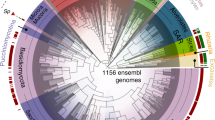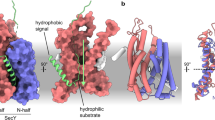Abstract
In bacteria, magnesium uptake is mainly mediated by the well-characterized CorA type of membrane proteins. In recent years, functional homologues have been characterized in the inner mitochondrial membrane of yeast and mammals (the MRS2/LPE10 type), in the plasma membrane of yeast (the ALR/MNR type) and, as an extended family of proteins, in the model plant Arabidopsis thaliana. Despite generally low sequence similarity, individual proteins can functionally complement each other over large phylogenetic distances. All these proteins are characterized by a universally conserved Gly-Met-Asn (GMN) motif at the end of the first of two conserved transmembrane domains near the C-terminus. Mutations of the GMN motif are known to abolish Mg2+ transport, but the naturally occurring variants GVN and GIN may be associated with the transport of other divalent cations, such as zinc and cadmium, respectively. We refer to this whole class of proteins as the 2-TM-GxN type. The functional membrane channel is thought to be formed by oligomers containing four or five subunits. The wealth of sequence data now available allows us to explore the evolutionary diversification of the basic 2-TM-GxN model within the so-called metal ion transporter (MIT) superfamily. Here we report phylogenetic analyses on more than 360 homologous protein sequences derived from genomic sequences from representatives of all three domains of life. Independent gene duplications have occurred in fungi, plants and proteobacteria at different phylogenetic depths. Moreover, there is ample evidence for several instances of horizontal gene transfer of members of the 2-TM-GxN superfamily in Eubacteria and Archaea. Only single genes of the MRS2 type have been identified in vertebrate genomes. In contrast, 15 members are found in the model plant Arabidopsis thaliana, which appear to have arisen by at least four independent founder events before the diversification of flowering plants. Phylogenetic clade assignment seems to correlate with alterations in the highly conserved sequence around the GMN motif. This presumably forms an integral part of the pore surface, and changes in its structure may result in altered transport capacities for different divalent cations.





Similar content being viewed by others
References
Akman L, Yamashita A, Watanabe H, Oshima K, Shiba T, Hattori M, Aksoy S (2002) Genome sequence of the endocellular obligate symbiont of tsetse flies, Wigglesworthia glossinidia. Nature Genet 32:402–407
Altschul SF, Gish W, Miller W, Myers EW, Lipman DJ (1990) Basic local alignment search tool. J Mol Biol 215:403–410
Arai M, Mitsuke H, Ikeda M, Xia JX, Kikuchi T, Satake M, Shimizu T (2004) ConPred II: a consensus prediction method for obtaining transmembrane topology models with high reliability. Nucleic Acids Res 32:W390–W393
Brayton KA, Kappmeyer LS, Herndon DR, Dark MJ, Tibbals DL, Palmer GH, McGuire TC, Knowles DP Jr (2005) Complete genome sequencing of Anaplasma marginale reveals that the surface is skewed to two superfamilies of outer membrane proteins. Proc Natl Acad Sci USA 102:844–849
Bui DM, Gregan J, Jarosch E, Ragnini A, Schweyen RJ (1999) The bacterial magnesium transporter CorA can functionally substitute for its putative homologue Mrs2p in the yeast inner mitochondrial membrane. J Biol Chem 274:20438–20443
Busch W, Saier MH (2002) The Transporter Classification (TC) system, 2002. Crit Rev Biochem Mol Biol 37:287–337
Caldwell AM, Smith RL (2003) Membrane topology of the ZntB efflux system of Salmonella enterica serovar typhimurium. J Bacteriol 185:374–376
Chubanov V, Waldegger S, Schnitzler M, Vitzthum H, Sassen MC, Seyberth HW, Konrad M, Gudermann T (2004) Disruption of TRPM6/TRPM7 complex formation by a mutation in the TRPM6 gene causes hypomagnesemia with secondary hypocalcemia. Proc Natl Acad Sci USA 101:2894–2899
Dujon B, et al. (2004) Genome evolution in yeasts. Nature 430:35–44
Gardner RC (2003) Genes for magnesium transport. Curr Opin Plant Biol 6:263–267
Graschopf A, Stadler JA, Hoellerer MK, Eder S, Sieghardt M, Kohlwein SD, Schweyen RJ (2001) The yeast plasma membrane protein Alr1 controls Mg2+ homeostasis and is subject to Mg2+ -dependent control of its synthesis and degradation. J Biol Chem 276:16216–16222
Gregan J, Bui DM, Pillich R, Fink M, Zsurka G, Schweyen RJ (2001a) The mitochondrial inner membrane protein Lpe10p, a homologue of Mrs2p, is essential for magnesium homeostasis and group II intron splicing in yeast. Mol Gen Genet 264:773–781
Gregan J, Kolisek M, Schweyen RJ (2001b) Mitochondrial Mg(2+) homeostasis is critical for group II intron splicing in vivo. Genes Dev 15:2229–2237
Haynes WJ, Kung C, Saimi Y, Preston RR (2002) An exchanger-like protein underlies the large Mg2+ current in Paramecium. Proc Natl Acad Sci USA 99:15717–15722
Hmiel SP, Snavely MD, Miller CG, Maguire ME (1986) Magnesium transport in Salmonella typhimurium: characterization of magnesium influx and cloning of a transport gene. J Bacteriol 168:1444–1450
Hmiel SP, Snavely MD, Florer JB, Maguire ME, Miller CG (1989) Magnesium transport in Salmonella typhimurium: genetic characterization and cloning of three magnesium transport loci. J Bacteriol 171:4742–4751
Kehres DG, Maguire ME (2002) Structure, properties and regulation of magnesium transport proteins. Biometals 15:261–270
Kehres DG, Lawyer CH, Maguire ME (1998) The CorA magnesium transporter gene family. Microb Comp Genomics 3:151–169
Kolisek M, Zsurka G, Samaj J, Weghuber J, Schweyen RJ, Schweigel M (2003) Mrs2p is an essential component of the major electrophoretic Mg2+ influx system in mitochondria. EMBO J 22:1235–1244
Krogh A, Larsson B, von Heijne G, Sonnhammer EL (2001) Predicting transmembrane protein topology with a hidden Markov model: application to complete genomes. J Mol Biol 305:567–580
Kumar S, Tamura K, Nei M (2004) MEGA3: integrated software for molecular evolutionary genetics analysis and sequence alignment. Brief Bioinf 5:150–163
Li L, Tutone AF, Drummond RS, Gardner RC, Luan S (2001) A novel family of magnesium transport genes in Arabidopsis. Plant Cell 13:2761–2775
Liu GJ, Martin DK, Gardner RC, Ryan PR (2002) Large Mg2+ -dependent currents are associated with the increased expression of ALR1 in Saccharomyces cerevisiae. FEMS Microbiol Lett 213:231–237
MacDiarmid CW, Gardner RC (1998) Overexpression of the Saccharomyces cerevisiae magnesium transport system confers resistance to aluminum ion. J Biol Chem 273:1727–1732
Maguire ME, Cowan JA (2002) Magnesium chemistry and biochemistry. Biometals 15:203–210
Mergeay M, Monchy S, Vallaeys T, Auquier V, Benotmane A, Bertin P, Taghavi S, Dunn J, van der Lelie D, Wattiez R (2003) Ralstonia metallidurans, a bacterium specifically adapted to toxic metals: towards a catalogue of metal-responsive genes. FEMS Microbiol Rev 27:385–410
Moller S, Croning MDR, Apweiler R (2001) Evaluation of methods for the prediction of membrane spanning regions. Bioinformatics 17:646–653
Moncrief MB, Maguire ME (1999) Magnesium transport in prokaryotes. J Biol Inorg Chem 4:523–527
Nelson KE, et al. (1999) Evidence for lateral gene transfer between Archaea and Bacteria from genome sequence of Thermotoga maritima. Nature 399:323–329
Noel-Georis I, Vallaeys T, Chauvaux R, Monchy S, Falmagne R, Mergeay M, Wattiez R (2004) Global analysis of the Ralstonia metallidurans proteome: Prelude for the large-scale study of heavy metal response. Proteomics 4:151–179
Obrdlik P, El Bakkoury M, Hamacher T, Cappellaro C, Vilarino C, Fleischer C, Ellerbrok H, Kamuzinzi R, Ledent V, Blaudez D, Sanders D, Revuelta JL, Boles E, Andre B, Frommer WB (2004) K+ channel interactions detected by a genetic system optimized for systematic studies of membrane protein interactions. Proc Natl Acad Sci USA 101:12242–12247
Ochman H, Daubin V, Lerat E (2005) A bunch of fun-guys: the whole-genome view of yeast evolution. Trends Genet 21:1–3
Rhodes G, Parkhill J, Bird C, Ambrose K, Jones MC, Huys G, Swings J, Pickup RW (2004) Complete nucleotide sequence of the conjugative tetracycline resistance plasmid pFBAOT6, a member of a group of IncU plasmids with global ubiquity. Appl Env Microbiol 70:7497–7510
Schmitz C, Perraud AL, Johnson CO, Inabe K, Smith MK, Penner R, Kurosaki T, Fleig A, Scharenberg AM (2003) Regulation of vertebrate cellular Mg2+ homeostasis by TRPM7. Cell 114:191–200
Schock I, Gregan J, Steinhauser S, Schweyen R, Brennicke A, Knoop V (2000) A member of a novel Arabidopsis thaliana gene family of candidate Mg2+ ion transporters complements a yeast mitochondrial group II intron-splicing mutant. Plant J 24:489–501
Schwacke R, Schneider A, van der Graaff E, Fischer K, Catoni E, Desimone M, Frommer WB, Flugge UI, Kunze R (2003) ARAMEMNON, a novel database for Arabidopsis integral membrane proteins. Plant Physiol 131:16–26
Shaul O, Hilgemann DW, Almeida-Engler J, Van Montagu M, Inzé D, Galili G (1999) Cloning and characterization of a novel Mg(2+)/H(+) exchanger. EMBO J 18:3973–3980
Smith RL, Maguire ME (1998) Microbial magnesium transport: unusual transporters searching for identity. Mol Microbiol 28:217–226
Smith RL, Banks JL, Snavely MD, Maguire ME (1993) Sequence and topology of the CorA magnesium transport systems of Salmonella typhimurium and Escherichia coli. Identification of a new class of transport protein. J Biol Chem 268:14071–14080
Smith RL, Thompson LJ, Maguire ME (1995) Cloning and characterization of MgtE, a putative new class of Mg2+ transporter from Bacillus firmus OF4. J Bacteriol 177:1233–1238
Smith RL, Gottlieb E, Kucharski LM, Maguire ME (1998a) Functional similarity between archaeal and bacterial CorA magnesium transporters. J Bacteriol 180:2788–2791
Smith RL, Szegedy MA, Kucharski LM, Walker C, Wiet RM, Redpath A, Kaczmarek MT, Maguire ME (1998b) The CorA Mg2+ transport protein of Salmonella typhimurium—mutagenesis of conserved residues in the third membrane domain identifies a Mg2+ pore. J Biol Chem 273:28663–28669
Snavely MD, Florer JB, Miller CG, Maguire ME (1989) Magnesium transport in Salmonella typhimurium: 28 Mg2+ transport by the CorA, MgtA, and MgtB systems. J Bacteriol 171:4761–4766
Sonnhammer EL, von Heijne G, Krogh A (1998) A hidden Markov model for predicting transmembrane helices in protein sequences. Proc Int Conf Intell Syst Mol Biol 6:175–182
Szegedy MA, Maguire ME (1999) The CorA Mg2+ transport protein of Salmonella typhimurium—mutagenesis of conserved residues in the second membrane domain. J Biol Chem 274:36973–36979
Townsend DE, Esenwine AJ, George J, III, Bross D, Maguire ME, Smith RL (1995) Cloning of the mgtE Mg2+ transporter from Providencia stuartii and the distribution of mgtE in gram-negative and gram-positive bacteria. J Bacteriol 177:5350–5354
Warren MA, Kucharski LM, Veenstra A, Shi L, Grulich PF, Maguire ME (2004) The CorA Mg2+ transporter is a homotetramer. J Bacteriol 186:4605–4612
Wiesenberger G, Waldherr M, Schweyen RJ (1992) The nuclear gene MRS2 is essential for the excision of group II introns from yeast mitochondrial transcripts in vivo. J Biol Chem 267:6963–6969
Worlock AJ, Smith RL (2002) ZntB is a novel Zn2+ transporter in Salmonella enterica serovar Typhimurium. J Bacteriol 184:4369–4373
Zsurka G, Gregan J, Schweyen RJ (2001) The human mitochondrial Mrs2 protein functionally substitutes for its yeast homologue, a candidate magnesium transporter. Genomics 72:158–168
Acknowledgements
Research in the authors’ laboratory on the plant AtMRS2 gene family is supported by the DFG (Deutsche Forschungsgemeinschaft; Grant Kn411/4) in the context of Priority Programme SPP1108 (Plant Membrane Transport).
Author information
Authors and Affiliations
Corresponding author
Additional information
Communicated by R. Hagemann
Electronic supplementary material
Rights and permissions
About this article
Cite this article
Knoop, V., Groth-Malonek, M., Gebert, M. et al. Transport of magnesium and other divalent cations: evolution of the 2-TM-GxN proteins in the MIT superfamily. Mol Genet Genomics 274, 205–216 (2005). https://doi.org/10.1007/s00438-005-0011-x
Received:
Accepted:
Published:
Issue Date:
DOI: https://doi.org/10.1007/s00438-005-0011-x




